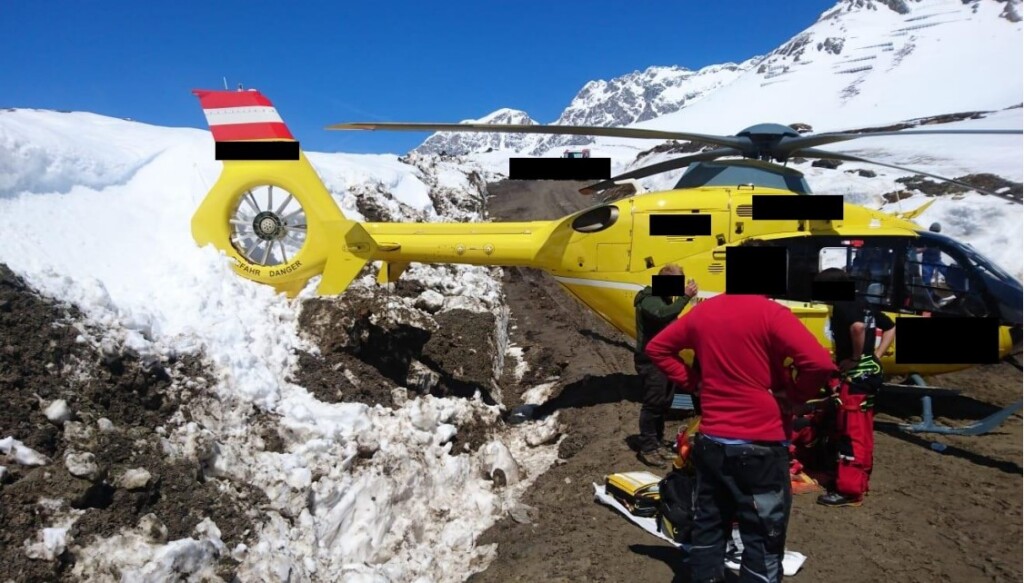HEMS Pilot Seizure While Rotor-Running (ÖAMTC Airbus EC135T2+ OE-XVD)
On 23 May 2019, HEMS Airbus EC135T2+ air ambulance OE-XVD of ÖAMTC was tasked to attend to an injured construction worker at the Galzig ski resort, near St. Anton, in the Tyrolean Alps, Austria. While on scene, rotors running, while the casualty was being loaded, the helicopter began to slide. The EC135 yawed approximately 270° until the tail struck a snow bank. The impact ejected the half-loaded casualty, who received a further minor injury. The Sicherheitsuntersuchungsstelle des Bundes (SUB) issued their safety investigation report (in German only) on 28 February 2022.

ÖAMTC Airbus EC135T2+ OE-XVD HEMS Pilot Medical Emergency Incident (Credit Witness via SUB, with Identity Marking Redacted by SUB)
The SUB report explains that the doctor alerted the pilot by radio to the aircraft movement when they detected it starting, but received no response. When the doctor looked into the cockpit, he saw that the pilot was standing on the anti-torque pedals, with his hands clenched in front of his chest, having a seizure. There had been no prior warning signs of an impending medical emergency.
As a consequence of this seizure the pilot lost control of the helicopter. The helicopter’s tail brushed against an embankment before being stopped by the collision with a wall of snow. The pilots convulsions continued for 2-3 minutes.
The pilot was aged 42 and held a Class 1 Medical Certificate issued on 28 March 2019 (less than 2 months before). The pilot had however suffered what was classed a traumatic brain injury in a domestic accident in May 2017 and spent 4 days in hospital. The pilot underwent a series of tests and medicals subsequent to the head injury that were considered ‘comprehensive’ by the investigation’s specialist advisor. Apart from a slight loss of hearing in one ear no long-term issues were detected. The pilot was cleared to fly again in November 2017 and was being examined by a specialist every 6 months. After the May 2019 occurrence, his medical certification was removed.
As part of the investigation, the possibility of flicker vertigo induced fit due to flickering sunlight through the main rotor. On an EC135 this frequency is 26.3 Hz, which is outside the 4-20 Hz range that research has established is critical for flicker vertigo.
The investigators report that the operator already had numerous elements from EASA AMC1 CAT.GEN.MPA.215 Pilot Support Programme in advance of the regulatory deadline. The investigators comment that the operator…
…convincingly demonstrated that it has a Just Culture and a safety-oriented culture as a prerequisite for an EASA support program and that it has taken several damage-reducing and livelihood precautions in the event of a pilot losing his license.
The Investigator’s Conclusions
The helicopter lost control due to pilot medical emergency.
The expert commissioned by the federal safety investigation agency sees the previous craniocerebral trauma as the most likely trigger for the tonic-clonic seizure.
The company offered the pilot extensive support.
Safety Resources
The European Safety Promotion Network Rotorcraft (ESPN-R) has a helicopter safety discussion group on LinkedIn. You may also find these Aerossurance articles of interest:
- Dry Ice Packing Error Incapacitated Pilot on Taxiway
- Austrian Police EC135P2+ Impacted Glassy Lake
- Fish Spotting Helicopter Strikes Glassy Sea
- EC135P2 Spatial Disorientation Accident
- Canadian Flat Light CFIT
- HEMS EC135T1 CFIT During Mountain Take Off in Poor Visibility
- Air Ambulance Leaps into Air: Misrigged Flying Controls
- A HEMS Helicopter Had a Lucky Escape During a NVIS Approach to its Home Base
- Pedestrian Seriously Injured by Air Ambulance Landing at Melbourne Hospital
- Air Ambulance B407 Hospital Helipad Deck Edge Tail Strike During Shallow Approach
- Why a Collective Control Came Loose in a Pilot’s Hand…
- Man Hit By Aircraft During Arctic Nuclear Sub Exercise
- UPDATE 4 February 2024: HEMS Air Ambulance Landing Site Slide
Aerossurance is delighted to sponsor the European Society of Air Safety Investigators (ESASI) Regional Seminar 2022 in Budapest, Hungary 6-7 April 2022.


Recent Comments